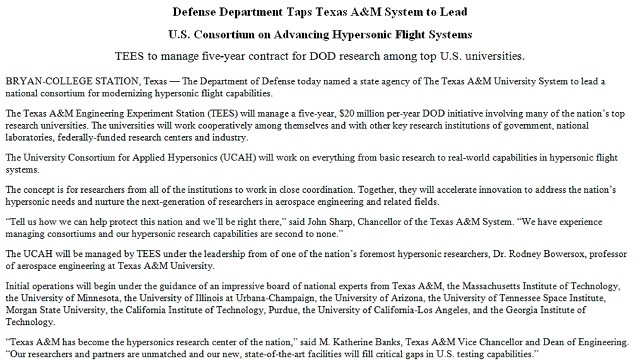
The Texas A&M system’s engineering experiment station (TEES) will be leading a five year, $100 million dollar defense department project.
Chancellor John Sharp says A&M and 40 other research universities are also participating in modernizing hypersonic flight capabilities.
The system’s news release states the universities “will work on everything from basic research to real-world capabilities in hypersonic flight systems.”
According to the news release, “The concept is for researchers from all of the institutions to work in close coordination. Together, they will accelerate innovation to address the nation’s hypersonic needs and nurture the next-generation of researchers in aerospace engineering and related fields.”
Sharp says the timing could not be better, as the system prepares to build the nation’s biggest enclosed hypersonic testing range on the RELLIS campus. That was among the subjects the chancellor brought up during an appearance at the October meeting of the A&M faculty senate.
Click below for comments from John Sharp during the October 12, 2020 Texas A&M faculty senate meeting about hypersonic research.
News release from the Texas A&M system about the TEES contract with the defense department:
The Department of Defense today named a state agency of The Texas A&M University System to lead a national consortium for modernizing hypersonic flight capabilities.
The Texas A&M Engineering Experiment Station (TEES) will manage a five-year, $20 million per-year DOD initiative involving many of the nation’s top research universities. The universities will work cooperatively among themselves and with other key research institutions of government, national laboratories, federally-funded research centers and industry.
The University Consortium for Applied Hypersonics (UCAH) will work on everything from basic research to real-world capabilities in hypersonic flight systems.
The concept is for researchers from all of the institutions to work in close coordination. Together, they will accelerate innovation to address the nation’s hypersonic needs and nurture the next-generation of researchers in aerospace engineering and related fields.
“Tell us how we can help protect this nation and we’ll be right there,” said John Sharp, Chancellor of the Texas A&M System. “We have experience managing consortiums and our hypersonic research capabilities are second to none.”
The UCAH will be managed by TEES under the leadership from of one of the nation’s foremost hypersonic researchers, Dr. Rodney Bowersox, professor of aerospace engineering at Texas A&M University.
Initial operations will begin under the guidance of an impressive board of national experts from Texas A&M, the Massachusetts Institute of Technology, the University of Minnesota, the University of Illinois at Urbana-Champaign, the University of Arizona, the University of Tennessee Space Institute, Morgan State University, the California Institute of Technology, Purdue, the University of California-Los Angeles, and the Georgia Institute of Technology.
“Texas A&M has become the hypersonics research center of the nation,” said M. Katherine Banks, Texas A&M Vice Chancellor and Dean of Engineering. “Our researchers and partners are unmatched and our new, state-of-the-art facilities will fill critical gaps in U.S. testing capabilities.”
The DOD contract comes as Texas A&M System is preparing to build the biggest enclosed hypersonic testing range in the nation as part of the George H. W. Bush Combat Development Complex (BCDC) on the RELLIS campus in Bryan.
The Ballistic Aero-Optics and Materials (BAM) will complement other cutting-edge hypersonic facilities at Texas A&M such as the National Aerothermochemistry and Hypersonics Laboratory (NAL) and the Aerospace Laboratory for Lasers, ElectroMagnetics and Optics (ALLEMO).
The UCAH approach will include a major focus on modeling and testing to facilitate earlier and more certain progress on developing hypersonic systems. The UCAH will become a collaborative hypersonic ecosystem to bridge the so-called “valley of death” between promising research possibilities and actual real-world capabilities.
TEES has already identified more than 41 institutions from at least 23 states committed to participating in the UCAH. Participation is expected to increase in upcoming months to include additional institutions from across the country and from Australia and the United Kingdom.
“This first-of-its kind Consortium will be critical to advancing hypersonics research and innovation, a key priority of the Department of Defense,” said Michael Kratsios, Acting Under Secretary of Defense for Research and Engineering. “Importantly, through collaborative industry and academic partnerships, it will also accelerate technology transfer and strengthen workforce development to meet the nation’s future warfighting needs.”
TEES currently manages a variety of consortia and brings extensive expertise in experimentation, logistics, contract management, workforce development and protection of national security-related research.
“It’s all headquartered here thanks to the support of Chancellor Sharp and the Texas A&M System,” Banks said.
